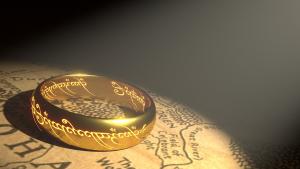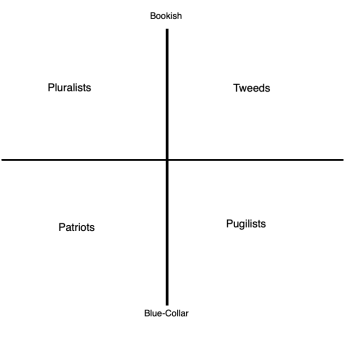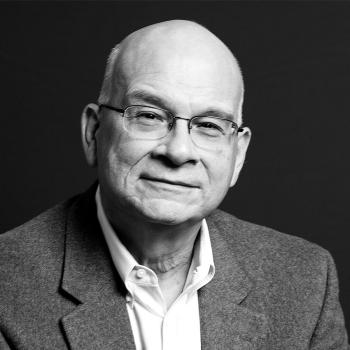
Few writers are more beloved—especially in Christian circles—than J. R. R. Tolkien, the British philologist behind The Hobbit, The Lord of the Rings, and a vast corpus of other Middle-earth materials. And for good reason: he was a genius. Wholly apart from his religious convictions, Tolkien’s impact on the entire domain of “fantasy literature” was nothing short of colossal—indeed, virtually every book in the genre today imitates some aspect of his work. Over the years, generations of young Christians have “graduated” from C. S. Lewis’s Chronicles of Narnia to Tolkien’s Middle-earth legendarium, and found themselves immediately in awe of Tolkien’s comprehensive worldbuilding.
But a reader thoroughly steeped in the ways of Narnia will promptly something surprising about Tolkien’s world: namely, its comparative “godlessness.” There are no churches or rites in Middle-earth, and not much theological discourse to speak of—besides the references the Elves make to “the West.”
This take on Tolkien ends up treating his grand tale as largely a collection of applied moralisms, which unfold against the backdrop of an epic struggle. From Frodo and Sam, we learn friendship, fidelity, and self-sacrifice. From Aragorn, we learn the character of nobility and virtue. From Gandalf, we learn hope. From the Ring, we learn of the evils of greed and power. And so it goes. Crucially, God isn’t really involved directly: to the casual Protestant reader, there’s an abstracted, deistic notion of Divine Providence overseeing the proceedings, but there’s nothing so dramatic as Aslan bursting in at the last second to defeat the White Witch.
Jonathan McIntosh wants to disrupt that reading. In The Flame Imperishable: Tolkien, St. Thomas, and the Metaphysics of Faerie, he argues for a distinctly Catholic Tolkien, one whose Thomistic metaphysical vision rests at the heart of his Middle-earth cosmology. Such a vision—unsurprisingly—is likely alien to most modern-day Tolkien aficionados (it certainly was to me when I first cracked open LOTR), but Tolkien’s work makes little sense apart from it.
The deep theology, if you will, of Tolkien’s work is largely found in The Silmarillion—a dense, sprawling tome chronicling thousands of years of Middle-earth history. (I happen to think it’s the best thing he ever produced, but I may be in the minority on that.) The Silmarillion opens with the Ainulindalë, a short novelette describing the creation of the world ex nihilo. In the beginning was Eru Ilúvatar, the One, who kindled the first beings with the Secret Fire. Together they began to craft a Great Music, the eponymous Ainulindalë, until the rebellious Melkor began to introduce his own dissonant notes. Through the unfolding of the Ainulindalë—and the tension between the music of Ilúvatar and the corruption of Melkor—Middle-earth came to be.
This introductory narrative is the backbone of McIntosh’s study. Clearly, it’s a rich and multifaceted retelling of the creation story, and McIntosh argues that it’s an important key to understanding the rest of Tolkien’s corpus.
For one thing—and I’m painting in the broadest possible strokes—McIntosh makes the case that the seeming “absence” of Ilúvatar from Tolkien’s popular works is, in fact, anything but that. Viewed through the lens of a Thomistic metaphysics of God—of God as the source and ground and end of all reality, at once both wholly transcendent and wholly immanent—it becomes clear that Ilúvatar is intimately present in every moment of the Lord of the Rings saga.
That’s interesting enough on its face, but it becomes even more compelling when developed further. In perhaps The Flame Imperishable’s most engaging chapter, McIntosh probes the tension between Thomistic and Ockhamist strains of metaphysical thinking in Tolkien’s work.
Here, a bit of background on the theologies of Aquinas and the later writer William of Ockham (the bugbear of many conservative criticisms of modernity, including Richard Weaver’s seminal Ideas Have Consequences) is in order. Ockham is perhaps best known for his criticism of metaphysical “universals”—that is, his argument against any consonance between conceptual categories and the real world in all its messy particularity. (When you hear someone today talk about how a given category is just a “social construct,” blame Ockham.)
But McIntosh goes in a slightly different direction, teasing out the implications of a seemingly arcane medieval dispute over the nature of God’s power. For Ockham, any limitation whatsoever on God’s omnipotence was unacceptable. Divine omnipotence transcended even logic itself, such that God could will a logical contradiction if he so chose. Indeed, the salience of the age-old chestnut—“can God create a rock so heavy he can’t lift it?”—depends on Ockhamist premises.
By contrast, for the Thomist, this view of omnipotence is pure nonsense. Logical possibility is grounded in God, the foundation of truth itself. Ockham’s questions, for the Thomist, are simply inept—akin to asking whether God could create a “square circle.” God’s inability to do so reflects a problem with the coherence of the concept, not a deficiency in God’s creative power.
Crucially, in McIntosh’s telling, Ockham drove a wedge between faith and reason that continues to afflict discourse today. A world where talk of God is decoupled from the norms of rationality—ironically, for theological reasons—is a world ultimately destined for secularity. As Umberto Eco memorably highlighted, Ockham’s theology even raises the chilling possibility that God might someday will his own nonexistence—a key theme in the work of 20th-century “Death of God” theologians and their intellectual heirs. This, for Tolkien the Thomist, was plainly unacceptable.
McIntosh’s historical reading isn’t distinctly original, but its application to Tolkien is highly novel. In particular, McIntosh posits that the Thomistic understanding of divine omnipotence underpinned Tolkien’s profound need for coherence in his imaginative storytelling. That is, Thomism—with its commitment to a fundamental consonance between faith and reason—helps explain why Tolkien spent so much time building out the contours of Middle-earth. Middle-earth had to be metaphysically plausible in order to meaningfully reflect a Christian theological paradigm: by telling his story with internal integrity, Tolkien understood himself as pointing to the God who stands at the nexus of faith and reason.
Naturally, McIntosh continues, other elements in Tolkien’s books are similarly pregnant with theological meaning. The One Ring, for instance, represents not merely the lust for power (in the naïve sense), but the lust for domination—that is, the metaphysical craving to impose one’s selfish desires upon ultimate Reality. It symbolizes not the lust to be king, but the lust to be God.
This plot element is intimately connected to Tolkien’s general antipathy toward technology. The Ring is, in a very real sense, a “technology of power” of the kind described by Michel Foucault in Discipline and Punish. It is an instrument used by an actor to distort the landscape of reality in accordance with their will. (Here McIntosh properly traces the parallels between Tolkien’s attitude towards technology and Martin Heidegger’s writing on the subject, although one wishes this section had been pulled from the footnotes into the body of the text.) For Tolkien, the proliferation of similar “control technologies” throughout modern society—as a result of industrialization and mass production—represented a serious spiritual failure. Hence, the much-maligned “Scouring of the Shire” sequence in The Return of the King is inextricable from Tolkien’s project.
The Flame Imperishable is so good that I hate to raise unnecessary quibbles, but it’s a shame that McIntosh largely refrains from placing Tolkien’s metaphysics into conversation with his ecological sensibilities—particularly here. The Catholic philosophical tradition provides plenty of resources for such an inquiry, particularly if one ventures beyond the boundaries of Thomism in the strictest sense—one thinks of Thomas Berry and Thomas Merton.
And Tolkien was more than willing to tackle the subject. The lore of the Elves—right down to the Two Trees of Valinor, whose light shines within the holy Silmaril gemstones—is bound up intimately with the destiny of the natural world. In the battle between the industrializing wizard Saruman and the ancient Ents at Isengard, Tolkien’s wrath towards the destruction and appropriation of nature comes into sharp relief. In the Scouring, we see Tolkien’s concern over the dissolution of traditional forms of community in the acid of modernity. On and on it goes.
In this emphasis, however, one grasps (albeit faintly) a deeply paradoxical element at the heart of Tolkien’s work.
McIntosh argues convincingly that one of Tolkien’s key purposes in crafting his legendarium was exploring the concept of “making” or “sub-creation”—of probing the extent to which the theologically-inflected imagination may range. In the notes accompanying his work, Tolkien frequently distinguishes between “creating” in the first and preeminent sense (the sole prerogative of God/Ilúvatar) and “making”—sub-creation, or “accidental causation” (to use the Aristotelian terminology). The novelist, for Tolkien, is less a creator than a maker: he works within an overarching framework of logic and order that preexists him.
This factors into Tolkien’s account of the Orcs and Trolls, lifeforms “made” by Melkor in crude imitation of the Men and Elves created by Ilúvatar. Tolkien was careful to distinguish this “making” from an independent act of “creation”—that is, production ex nihilo of that which has no ground of being in itself. Thus the Orcs and Trolls, while “made” by Melkor in the narrow sense, were still “created” in the sense that their ontological source was ultimately Ilúvatar, the absolute First Cause.
Certainly Tolkien’s own work was a great feat of “making,” a feat of imaginative genius that manifests and celebrates sub-creation at every level. Yet this same spirit of “making”—the application of human manipulative faculties to the existing canvas of creation—is the essence of the technological fixation Tolkien critiques so fiercely. It is, in short, a resistance to the sheer “givenness” of the world as we initially encounter it.
Viewed in a certain light, one wonders whether the impulse driving Tolkien to structure Middle-earth in painstaking detail was the same impulse driving his characters to industrialize the pastoral Shire. That impulse urges us to say that the world isn’t good enough as it is, so we ought to remake it to order. It’s a disquieting thought, to be sure—and challenging to reconcile with Tolkien’s fierce opposition to the destruction of the natural environment.
And this tension continues to play out in culture today. There’s a reading in which World of Warcraft and its ilk, despite their superficial similarities to Tolkien’s world, are in fact its most profound degradation. They throw up virtual barriers to engagement with the world on its own terms—and, necessarily, to the possibility of contemplating its transcendent source. What they offer instead is a sterile counterfeit, an artifact of human “making” that sands off the rough edges of reality and flatters our degraded sensibilities. It’s essentially the Ready Player One problem.
But there’s also a reading in which the rise of virtual reality—of hyper-immersive illusion—is the ultimate culmination of Tolkien’s “sub-creative” project. Massive multiplayer online worlds, particularly when coupled with the innovations of the Oculus Rift or similar systems, allow for worldbuilding on a scale hardly dreamt of by Tolkien. Designers of these new worlds pay intimate attention not merely to the cultures, but to the physics, of imaginary lands. Undoubtedly it’s not “creation” in the primal sense, but is this not still a great triumph of “making”?
These issues are not truly metaphysical, but rather ethical—matters of our orientation and obligations toward a Good that exists beyond ourselves. As such, these issues fall largely outside the scope of McIntosh’s work. But it’s an important point nonetheless: at what juncture does the imaginative/creative impulse becomes the temptation epitomized by the One Ring—the need for a world of one’s own devising, forged in one’s own image?
There have been a lot of conversations in popular culture lately about “toxic fandom,” stemming in large part from online backlash against the film Star Wars: The Last Jedi. Actors have been hounded offline, directors have been harassed, and gallons of digital bile have been spewed. This naturally raises an important question: why are people today so deeply attached to this sci-fi series?
My favorite extended essay on the topic advances a status-anxiety hypothesis—that most Star Wars trolls are angry white men upset by a changing world, and that more than anything what they crave is something that indulges their childish power fantasies. There’s probably some truth here, but I’m inclined to approach the question in a different, broader way. I tend to think that any obsessive devotion to fantasy entertainment is rooted in the felt need to be a “maker” in the more problematic, “Melkorian” sense.
This fixation emerges from the recognition that the world isn’t what it ought to be, and—the crucial part—the deeply felt belief that it ought to conform more precisely to our wishes. If there’s no obvious way to make that happen, why not withdraw into a sphere of entertainment where those desires can be flattered? Certainly this is an instinct that crosses racial, cultural, religious, and political lines. It’s an issue of empowerment fantasy, to be sure—but it turns on a universal longing.
Framing the challenge this way, I think, helps us see the ultimate resolution Tolkien would likely provide to the very paradox his work reflects: any act of “making” is only an end—in the ethical sense—insofar as it allows us to glimpse the deeper truths of fundamental Reality more clearly. As soon as the orientation of “making” shifts toward the self—as soon as it becomes co-opted into a display of personal vanity—the seduction of the Ring rears its head.
In one of the best passages of The Return of the King, as the faithful Sam struggles against the Ring’s allure, Tolkien captures this with special clarity:
Wild fantasies arose in his mind; and he saw Samwise the Strong, Hero of the Age, striding with a flaming sword across the darkened land, and armies flocking to his call as he marched to the overthrow of Barad-dûr. And then all the clouds rolled away, and the white sun shone, and at his command the vale of Gorgoroth became a garden of flowers and trees and brought forth fruit. He had only to put on the Ring and claim it for his own, and all this could be.
But even in his instant of temptation, Sam doesn’t waver:
[D]eep down in him lived still unconquered his plain hobbit-sense: he knew in the core of his heart that he was not large enough to bear such a burden, even if such visions were not a mere cheat to betray him. The one small garden of a free gardener was all his need and due, not a garden swollen to a realm; his own hands to use, not the hands of others to command
At the greatest moment of risk, what rescues Sam is a sense of individual humility and a trust in the inherent goodness of the given—the one small garden of a free gardener. There is no need for any “making”—any attempt to force the world to conform to his command—beyond what natural and moral limits have marked out. And crucially, those natural and moral limits are extrinsic to the self.
As McIntosh makes clear, all across Tolkien’s literary work, the scope of his legendarium is limited by his own recognition of limitation. Perhaps uncommonly for an author, Tolkien seems to understand deeply that in comparison to the splendor of the real, Middle-earth is a shadow on cave walls; its value lies in our ability to perceive the True more clearly, rather than in helping us escape it. By reminding his audience of not only the Christian Tolkien, but the Catholic Tolkien, McIntosh arms readers with the tools to engage these issues in a much more profound way.
In short, McIntosh’s volume is a fascinating, compelling read that belongs on any Tolkien fan’s bookshelf. (I’d venture it’ll have the same impact on Lord of the Rings discussion that Michael Ward’s Planet Narnia had on conversations about C. S. Lewis’s Chronicles.)
At least, I certainly hope so.












